10 Most Famous Mexican Paintings
The state of Mexico is 1 of the most unique cultures in the Western hemisphere. The art and lifestyle of its people are largely influenced by indigenous themes that trace their roots back to the 15th century before the Castilian conquest transformed the nation.
The artwork of the 15th century and prior was focused on the different religious behavior of the native tribes that inhabited the lands of Mexico.
In one case Christianity swept through the region in the 16th century, Mexico's artwork was forever changed and was mostly indicative of Christian ethics and values.
Despite centuries of rule that was tied to Catholicism, the people of United mexican states have never quite forgotten the colorful flare and influences of the indigenous people that called the country dwelling.
In one case Castilian authority was expelled in the early 1900'southward, Mexico and its people were gratuitous to once again explore the rare and vibrant styles of artwork that seem to define the region.
Taking a closer look at the ten nigh famous Mexican paintings reveals a lively and warm civilisation that is truly dissimilar whatever other on Earth.
Famous Mexican Paintings
one. The Two Frida'south – Frida Kahlo
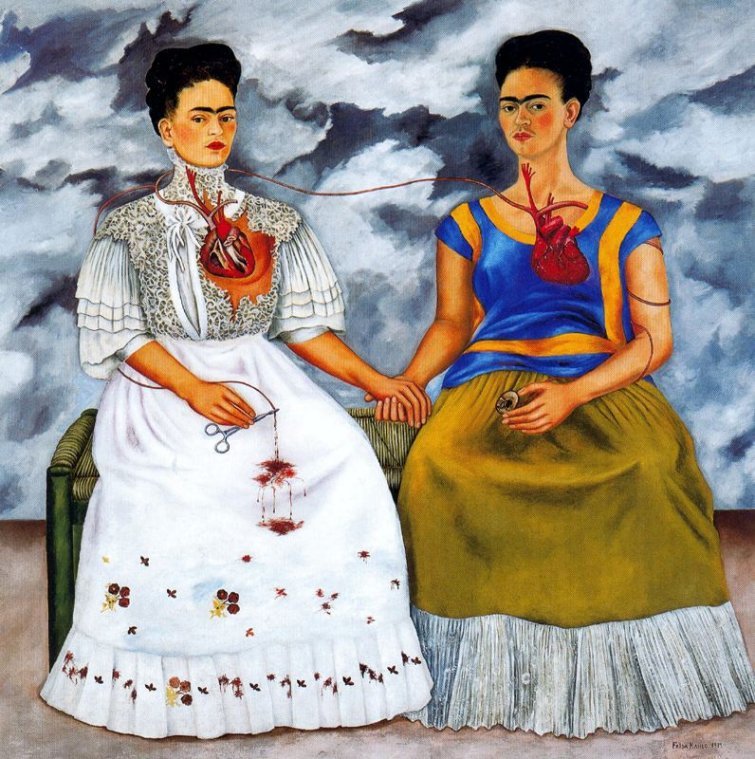
Mexican civilisation widely considers legendary creative person Frida Kahlo to be the most famous of Mexican painters. Known for her gripping and sometimes bizarre self-portraits, Kahlo'due south piece of work titled The Two Frida's is one that has long been considered a defining piece in Mexican art culture.
Kahlo was known for living equally passionately in real life as her artwork frequently portrays and this painting is a brilliant delineation of her feelings of duality, which were likely tied to her divorce with another famous Mexican painter, Diego Rivera.
The painting was completed in 1939 and shows i version of the artists dressed in a cute, flowing white dress that appears to be in the same fashion of European women's attire at the time.
The Frida on the correct, notwithstanding, is adorned with a traditional Mexican-mode dress that seems to exist more fitting for the Mexican artist'due south appearance.
The Frida on the left in the European dress is featured with a bleeding centre that is torn while the one on the correct's heart is shown unscathed.
This duality is thought to portray Kahlo'southward strong sense of belonging to Mexican culture in the face of what was certainly an overwhelming sense to assimilate with the more pop European style of the day for most artists.
This piece of work is meant to highlight Kahlo'due south belief that she must stay truthful to her Mexican roots, which is why well-nigh fine art enthusiasts and critics consider it one of the well-nigh moving Mexican paintings in existence.
2. The History of Mexico – Diego Rivera
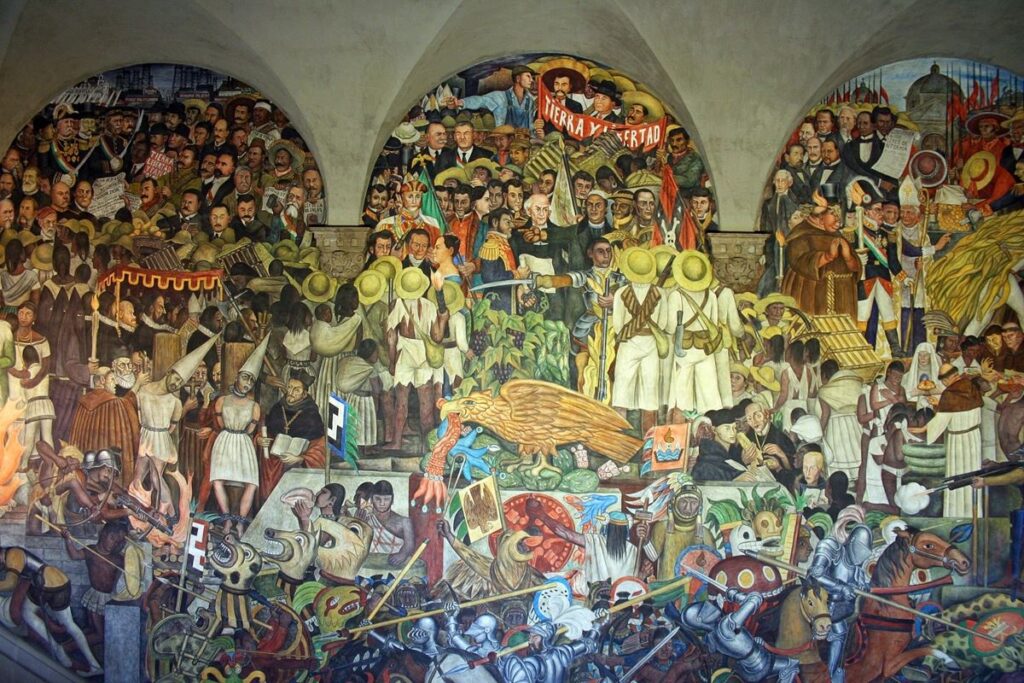
One of Mexico'due south most famous paintings was done, not on canvas, but every bit a mural upon a large main staircase within the National Palace of Mexico Urban center. Rivera was well-known for piece of work that featured scenes from a historical context and this painting, titled The History of Mexico was begun in 1929 and finally completed in 1935.
Beginning in what was considered the native Aztec period onward into what was the nowadays day Mexico during the time Rivera painted the piece of work, it consists of a litany of scenes that divers the country to its core.
It depicts the indigenous peoples being overtaken by Christian influence and the centuries that followed under Catholic faith.
Rivera focused heavily upon the nation's struggle for independence from Spain and the mural is alive with many famous figures that shaped United mexican states throughout the country's history.
The painting is one that beautifully captures much of the country'due south struggles and triumphs in one, sprawling work.
three. The Cleaved Column – Frida Kahlo
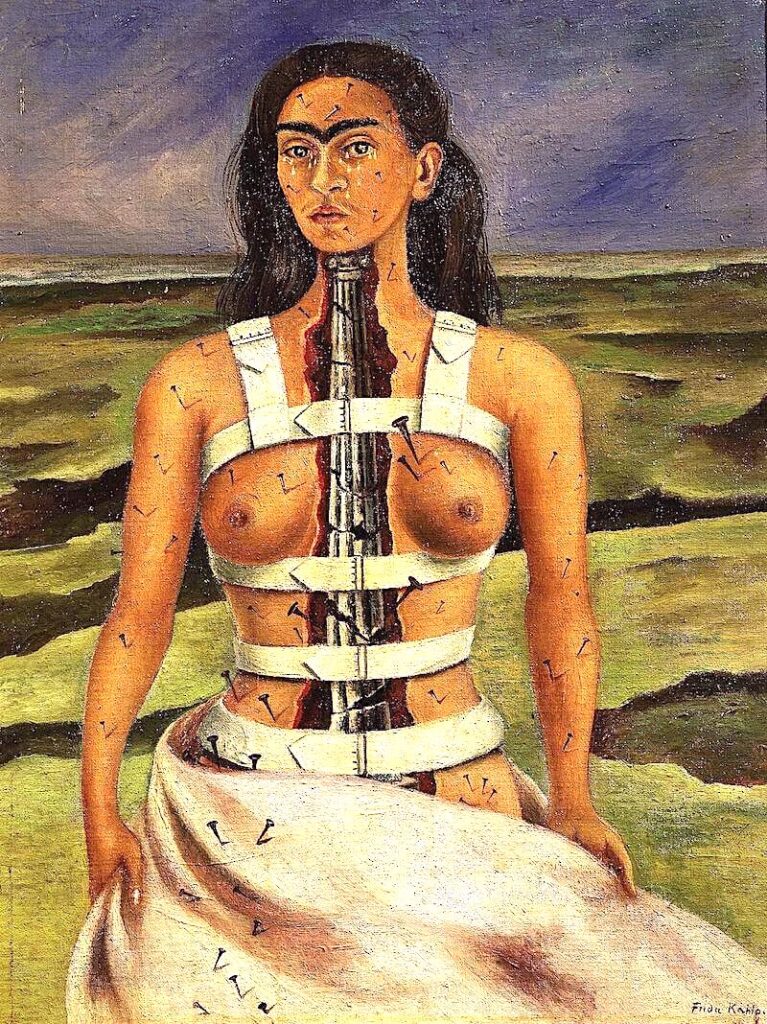
Frida Kahlo'south piece of work titled The Broken Column is some other one of her famous self-portraits that evokes a much greater meaning than superficial dazzler.
Kahlo was involved in a serious charabanc accident in the summer of 1925 and would forever live with severe pain and nagging injuries that resulted from the devastating outcome.
She had to suffer more than 30 different surgeries to repair some of the damage done in the accident and was left unable to bear children, which was said to weigh heavily on her heed from that bespeak on.
The painting was completed in 1944, many years after the accident, simply portrays a semi-nude Kahlo in a cute white dress. Her body is dotted with nails, probable symbolizing the persistent hurting that she was left with for many years post-obit the event.
Her spine is represented as a broken and crumbling cavalcade and the background of the painting is a barren landscape, which likely pointed to the devastating fact that she was unable to have children as a result of the crash.
4. La Calavera Catrina – José Guadalupe Posada
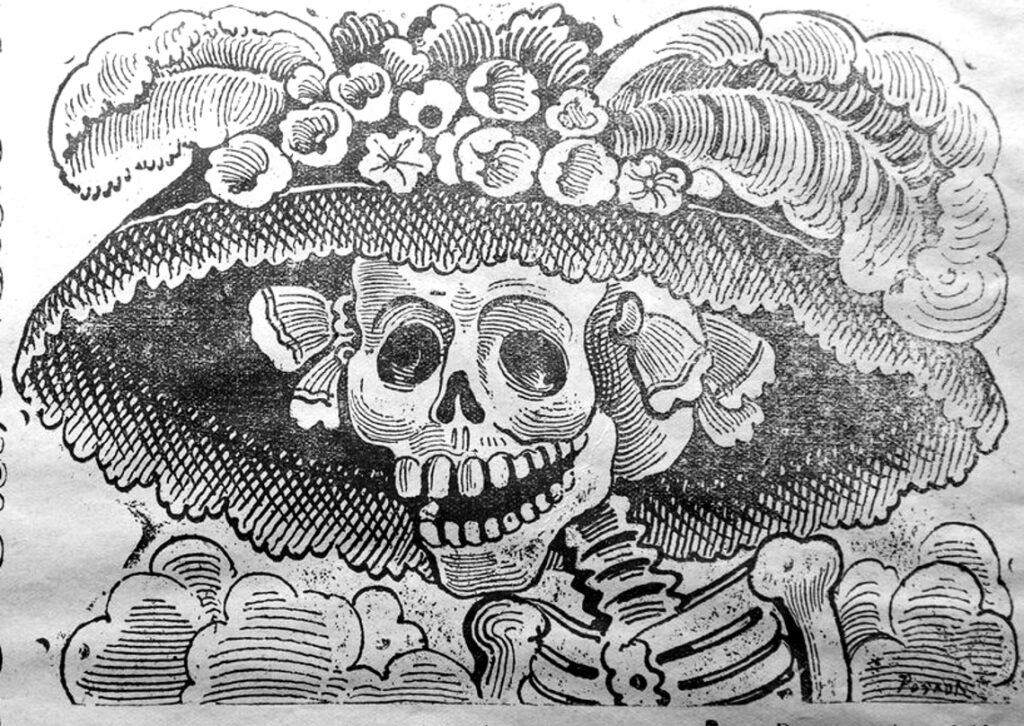
One of the most iconic pieces of Mexican painting was done by the famed José Guadalupe Posada in 1913.
Featuring a simple, yet elegantly-dressed female skeleton posed in a smiling fashion and wearing a lavish chapeau, the piece of work is a baroque paradox that incorporates the traditional Mexican respect of the dead with a dash of the European dress that was and then indicative of foreign influence in the nation.
Posada sought to highlight the tumultuous human relationship that Mexico had with European influence in a satirical mode that undoubtedly defenseless the attention of viewers and forced them to consider its significant.
The painting has since become a iconic effigy of the Mexican Day of the Dead and is displayed in many different forms.
5. Self-Portrait (Inn of the Dawn Horse) – Leonora Carrington
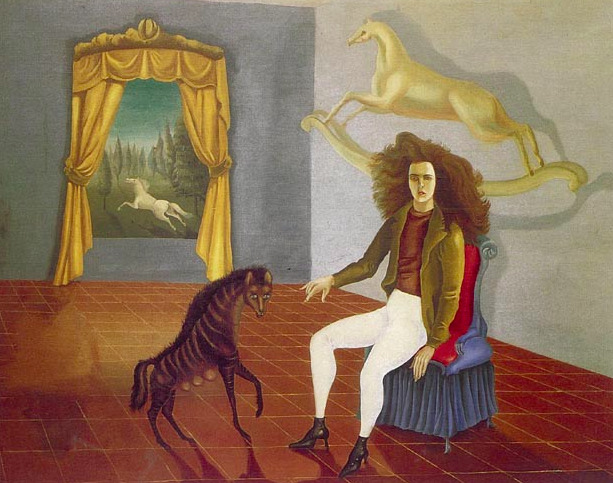
Mexican artwork has long been known for its surrealist influences, including the work of Leonora Carrington.
Her painting titled Cocky-Portrait (Inn of the Dawn Horse) was done in 1938 and features a strange scene that involves a gaunt Carrington sitting in a chair facing a female hyena. Behind her is a rocking horse hung on a wall while the window in the groundwork portrays a beautiful, galloping white stallion.
This painting's meaning has long been argued past art enthusiasts and critics alike.
Few have been able to definitively say what Carrington hoped to achieve with this work, but that level of mystery undoubtedly plays into the reasons why this painting is ane of United mexican states's virtually famous.
6. Human at the Crossroads – Diego Rivera
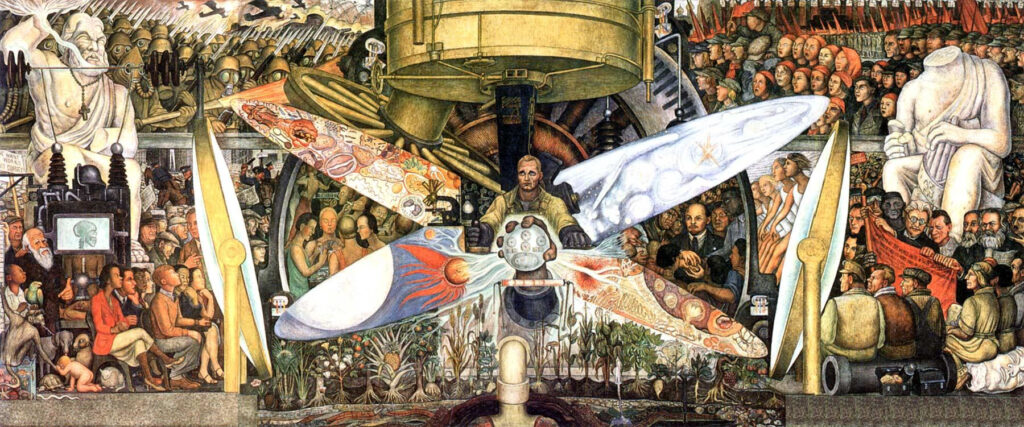
One of Rivera's most famous works was wracked in controversy and spanned two nations that were often at odds with one another. The work was originally painted at the request of the wealthy Rockefeller family in New York Urban center'southward Rockefeller Middle.
When the artist was faced with demands to remove a portrait of Vladimir Lenin, he refused to do so, which prompted the Rockefellers to order the removal of the work.
Rivera captured the details of his painting in a photograph and would after recreate information technology at the Palacio de Bellas Artes in United mexican states Metropolis in 1934. This defiant mensurate solidified the work equally i of the land's most famous paintings and stands to this day equally a symbol of Mexican individualism in the face of American influence.
7. Tres Personajes – Rufino Tamayo
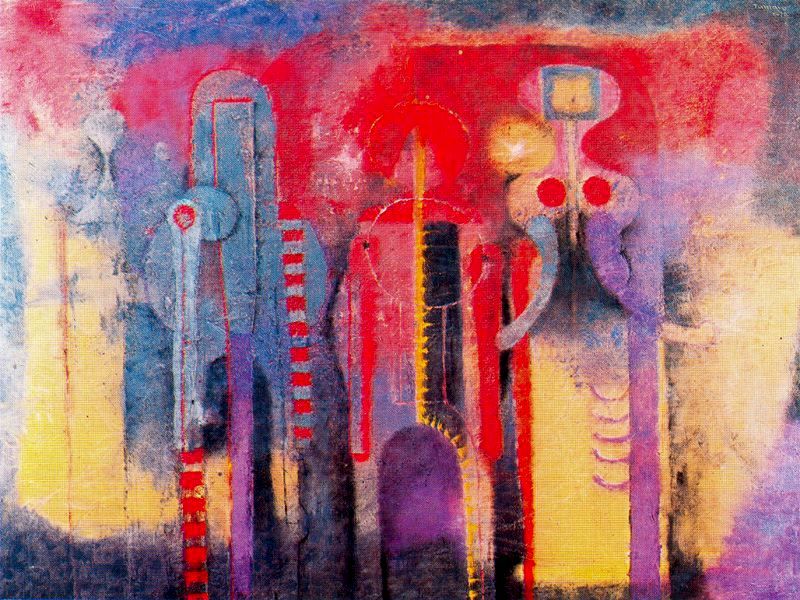
One of the most famous Mexican painters in the modernistic era is Rufino Tamayo. His painting, Tres Personajes depicts a vibrant and colorful scene of abstract expressionism that many consider to be one of the country'southward greatest works.
The 1970 painting portrays 3 figures that are highlighted by a dusky reddish hue, which is outlined by darker colors.
The contrasting colors and abrupt imagery work together to create a scene that is authentically Mexican in nature and widely viewed equally a testament to the country's culture.
eight. Echo of a Scream – David Alfaro Siqueiros
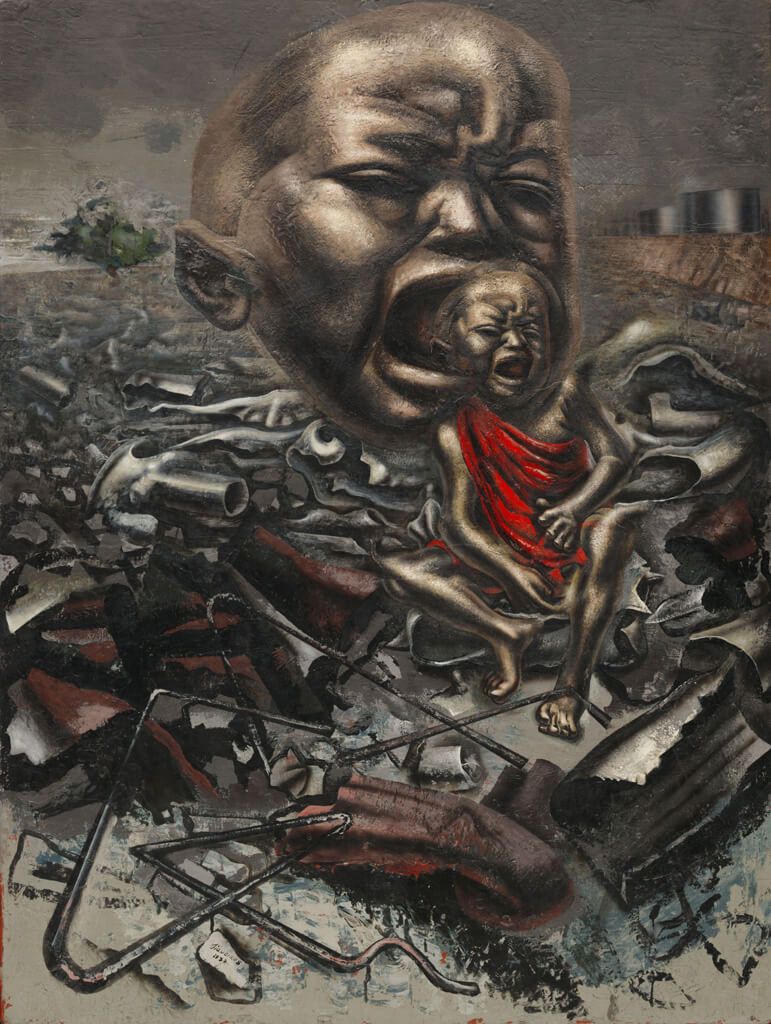
Surrealism has held a potent influence over much of Mexican artwork over the years and one such piece of work by David Alfaro Siqueiros is among the greatest in the famous style.
The painting is titled Echo of a Scream and features a disturbing scene in which a big crying child is shown amid devastation and desolation in the background.
The painting was done in 1937 and was likely meant to serve equally a portrayal of the horrors of war following the lasting imprint left by the Spanish Civil War.
The work is among the nigh gripping of Mexican artwork that is focused on the harsh nature of state of war.
9. Our Lady of Guadalupe – Pocket-size Basilica of Our Lady of Guadalupe
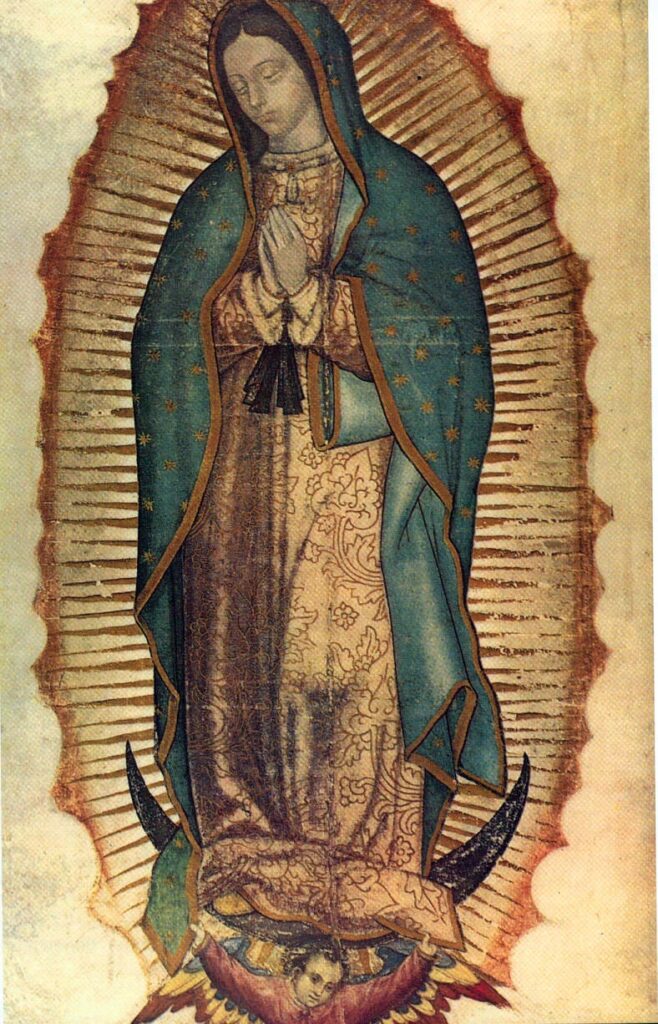
The ability of Christian artwork can be seen all over the land of Mexico and many of its most famous works have stood for nearly 500 years. The painting known as Our Lady of Guadalupe has supernatural origins dating back to 1531, according to Mexican history.
It is said that the work originated from an Aztec catechumen to Christianity known as Juan Diego, who came face to face with the Virgin Mary who asked that a shrine be built on the location where she appeared.
Diego reported this news to the archbishop who asked for proof. Once again, Diego is said to have returned to the Virgin Mary who instructed him to climb atop a nearby hill and gather flowers.
At the meridian, Diego constitute Castillan roses which were non native to the expanse and should not have been in bloom during that fourth dimension of year. Diego claimed the Virgin Mary arranged the roses inside his folded cloak and told him to return one time over again to the archbishop.
When he unfolded his cloak, the roses fell to the basis and revealed the image of the painting now known as Our Lady of Guadalupe.
x. Man, Controller of the Universe – Diego Rivera
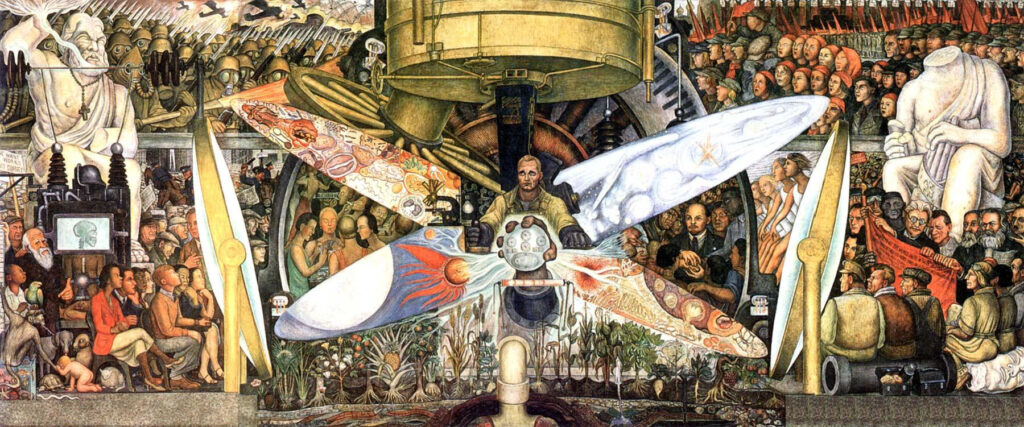
The painting known as Man, Controller of the Universe was the consequence of Diego Rivera's disharmonize that involved the Rockefeller family in the Usa. Rivera was commissioned to paint a big mural within Rockefeller Eye in New York City.
Later being told that his piece of work was unacceptable due to the fact that a portion of it depicted Vladimir Lenin, his piece of work was destroyed.
Rivera so left New York City and returned to Mexico where he painted a nearly identical image of the mural with the title Man, Controller of the Universe in 1934 at the Palacio de Bellas Artes in United mexican states City.
The piece of work is i that shows the stark contrasts in capitalism and socialism with much of the paintings' capitalist subjects depicted every bit lavishly smoking and enjoying themselves while others endure.
The contrasting socialist side of the painting shows Lenin joined in hands with a group of workers, highlighting a sense of equality.
We hope you have enjoyed our list of Famous Mexican Paintings!
Source: https://www.artst.org/famous-mexican-paintings/
Post a Comment for "10 Most Famous Mexican Paintings"